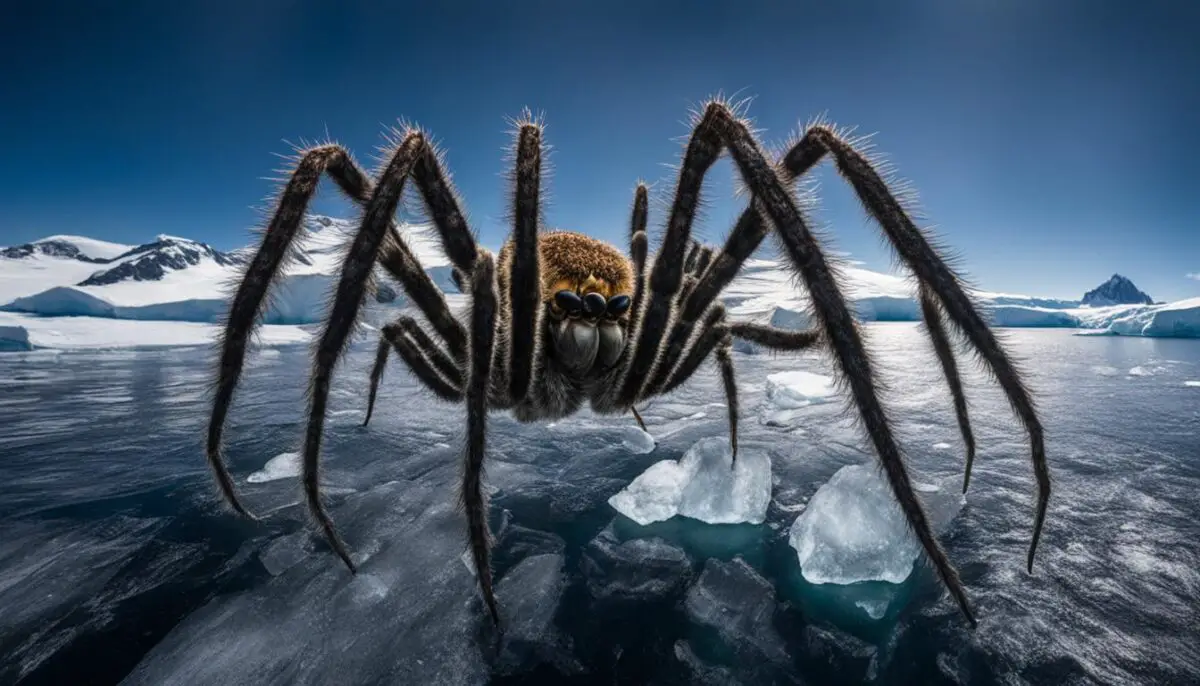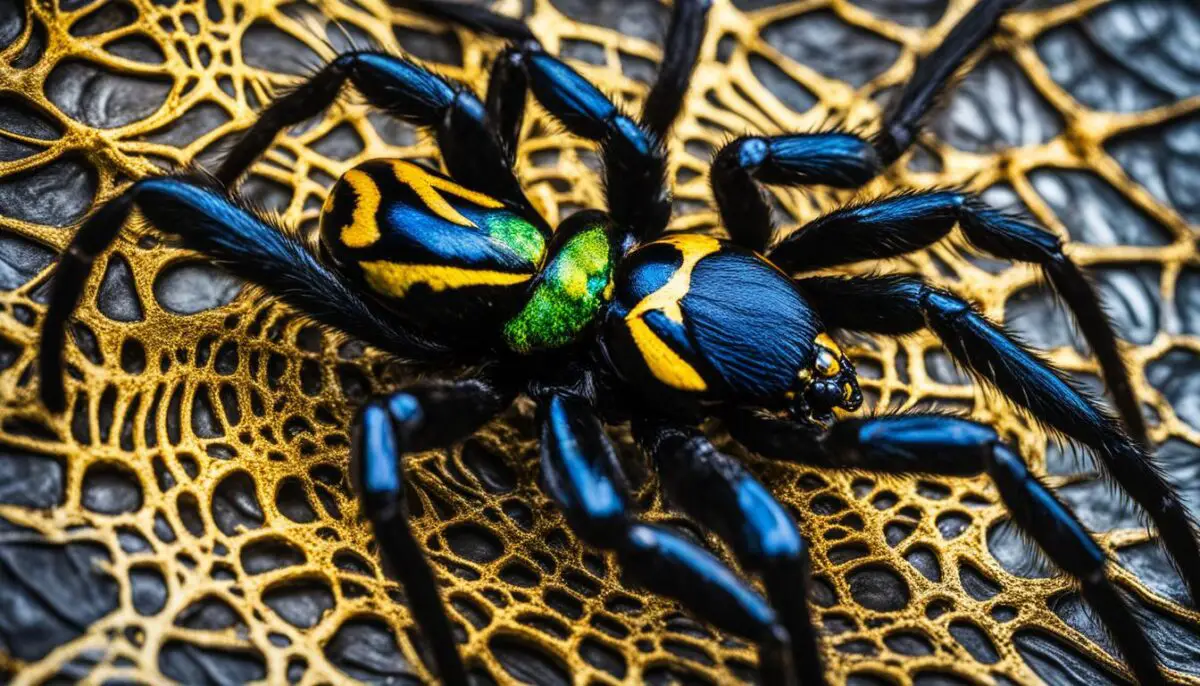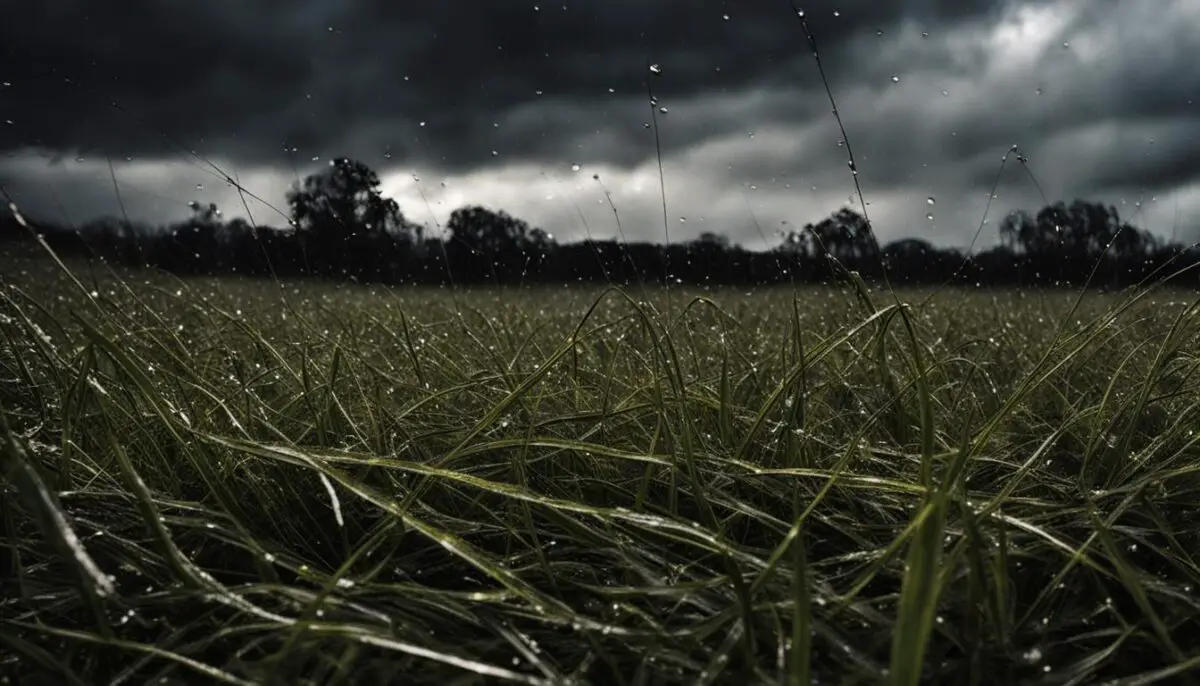Tarantulas, these mysterious and captivating creatures, have fascinated scientists and researchers for centuries. The discovery of tarantulas and their rich history remain an enigma, leaving us with unanswered questions. However, through the dedicated efforts of scientists and explorers, we have gained valuable insights into these fascinating creatures.
Join us on a journey as we delve into the intriguing world of tarantulas, exploring their diversity, behaviors, and unique adaptations. Let’s unravel the mysteries surrounding these creatures that have captivated the human imagination for centuries.
Key Takeaways:
- The discovery of tarantulas and their history remains a mystery.
- Scientists and researchers have made significant contributions to our understanding of tarantulas.
- Tarantulas are diverse creatures, with over 850 documented species.
- Unexplained behaviors, such as bizarre web formations, continue to intrigue scientists.
- Antarctica is home to giant sea spiders, exhibiting polar gigantism.
Who Discovered Tarantulas
The Diversity of Tarantulas
Tarantulas, with over 850 documented species, exhibit a remarkable diversity in characteristics and appearances. Ranging in size from as large as a human face to the smaller varieties, tarantulas come in a fascinating array of colors. Among these are the mesmerizing blue tarantulas, whose bright hue continues to puzzle scientists regarding its purpose. As researchers and scientists delve deeper into the taxonomy and identification of tarantulas, new species are constantly being discovered and classified.
| Tarantula Species | Size | Color |
|---|---|---|
| Theraphosa blondi (Goliath bird-eater) | Up to 30 cm | Brown |
| Poecilotheria metallica (Gooty sapphire ornamental) | 12-15 cm | Blue |
| Aphonopelma seemanni (Costa Rican zebra) | 10-12 cm | Black and white |
| Brachypelma smithi (Mexican redknee) | 13-15 cm | Red and black |
The classification of tarantulas is complex, requiring meticulous study and analysis. Scientists continue to explore the intricate web of relationships between different species and their evolutionary history. Through these efforts, researchers gain a deeper understanding of the diverse tarantula species and their place within the ecosystem. who discovered tarantulas
The Importance of Tarantula Identification
Accurate tarantula identification is crucial for various reasons. It enables scientists to study specific species and their behaviors, contributing to our knowledge of tarantula ecology and biology. Proper identification also plays an essential role in conservation efforts as it allows for targeted protection measures for endangered or threatened species. Moreover, identifying tarantulas helps enthusiasts and hobbyists in selecting suitable pets and understanding their care requirements.
- Identification guides
- Physical characteristics
- Habitat preferences
- Behavioral patterns
These are some of the factors that aid in the identification process. The ability to distinguish between different tarantula species is a valuable skill that contributes to our comprehensive understanding of these intriguing arachnids.
“The astonishing diversity of tarantulas never ceases to amaze researchers and enthusiasts alike. From their captivating colors to their unique adaptations, each species offers something new to discover.”
The world of tarantulas is richly diverse, showcasing a myriad of species with distinct characteristics. As our understanding of tarantula taxonomy and identification deepens, we unlock the secrets of these fascinating creatures, shedding light on their intricate evolutionary journeys. tarantula discovery
Unexplained Behavior: Bizarre Web Formations
In the vast, untouched forests of the Amazon, researchers have stumbled upon a puzzling mystery: bizarre web formations created by unknown species of spiders. These enigmatic structures consist of a small, intricately woven sphere surrounded by a meticulously crafted circular fence. The purpose of these web formations remains a subject of speculation and intrigue, leaving scientists with more questions than answers. history of tarantulas
At first glance, these intricate webs appear to serve as a defensive mechanism or a means to capture prey. The small, enclosed sphere could potentially act as a safe haven for the spider, shielding it from predators and providing a centralized location for trapping unsuspecting insects. However, this hypothesis is purely speculative, as no conclusive evidence has been found to support this theory. tarantula researchers
Further research is urgently needed to shed light on this fascinating behavior exhibited by these unknown spider species. By observing their hunting patterns, analyzing the specific structural elements of the webs, and studying the spiders’ behavior within these formations, scientists hope to unravel the mysteries surrounding these bizarre web formations. Understanding the purpose and function of these webs could provide valuable insights into the evolutionary adaptations and ecological roles of these enigmatic creatures. tarantula experts
Unraveling the Mystery
While the true nature of these webs remains shrouded in mystery, scientists are determined to uncover the secrets hidden within. By collecting samples, closely examining the unique characteristics of these web formations, and conducting experiments to observe the spiders’ behaviors, researchers aim to shed light on this enigmatic phenomenon. The study of these bizarre web formations not only contributes to our understanding of spider behavior, but also provides valuable insights into the complex web-building strategies employed by these elusive creatures.
| Spider Web Characteristics | Possible Explanations |
|---|---|
| Small, enclosed sphere | Potential defense mechanism |
| Circular fence surrounding the sphere | Possible prey capture strategy |
| Intricate and precise weaving | Unknown purpose, could be related to prey capture or structural stability |
| Unique web structure not seen in other spider species | Significant divergence in hunting strategies or ecological niche |
As scientists delve deeper into the intricate world of spider behavior, the mysteries of these bizarre web formations bring us one step closer to understanding the remarkable adaptations and behaviors exhibited by these fascinating creatures.
The Giant Sea Spiders of Antarctica
Antarctica, the frozen continent at the bottom of the world, is not only home to vast ice sheets and unique wildlife but also to an intriguing creature known as the giant sea spider. Contrary to their name, these sea spiders do not belong to the arachnid family but are actually marine arthropods. They have a mesmerizing presence with their long, spindly legs and large, translucent bodies. What makes them even more fascinating is their size, with some reaching diameters of 30-35 centimeters.

This extraordinary phenomenon is known as polar gigantism, where creatures in the Antarctic grow much larger than their relatives in warmer regions. The extreme cold temperatures of the Antarctic slow down the metabolism of these sea spiders, allowing them to invest more energy in growth. The exact mechanisms behind this evolution are still being studied by scientists, but the concept of polar gigantism provides insight into the adaptability and resilience of creatures in extreme environments.
Table: Comparing the Sizes of Sea Spiders
| Species | Size (Diameter in centimeters) |
|---|---|
| Giant Sea Spider (Antarctic) | 30-35 |
| Common Sea Spider (Temperate Regions) | 2-3 |
| Deep-Sea Sea Spider | Up to 8 |
Understanding the phenomenon of polar gigantism and the adaptations of these giant sea spiders provides valuable insights into the complexity of Antarctic ecosystems. By studying these fascinating creatures, scientists can gain a deeper understanding of the delicate balance of life in one of the harshest environments on Earth. famous tarantula explorers
How Spiders Avoid Getting Trapped in Their Own Webs
Spiders have evolved remarkable adaptations to navigate their intricate and sticky webs without getting trapped. These adaptations involve the secretion of an oily substance on their legs, which creates a protective layer against the sticky silk. Additionally, spiders have specialized leg structures and tiny barbs that help them move along the strands without becoming ensnared.
“Spiders have developed various mechanisms to avoid getting trapped in their own webs. Their legs are coated with an oily substance that prevents the silk from sticking to them. The angle of their legs and the presence of tiny barbs also aids in this process. These adaptations allow spiders to move freely on their webs, whether they are hunting for prey or building their intricate structures.”
The combination of these adaptations enables spiders to traverse their webs effortlessly, even when the silk strands are highly adhesive. Without these mechanisms, spiders would risk becoming entangled in their own webs, hindering their ability to capture prey and survive. tarantula naturalists
Spider Leg Adaptations
One key adaptation that spiders possess is the ability to control the angle of their legs as they move across the web. This angling helps minimize contact between their legs and the sticky silk, reducing the chances of entrapment. Furthermore, spiders’ legs feature tiny, hair-like structures called setae that have specialized barbs or hooks. These structures provide additional grip on the silk, allowing spiders to move swiftly without sticking.
| Spider Leg Adaptations | Description |
|---|---|
| Leg Coating | Spiders secrete an oily substance on their legs, creating a protective layer against the stickiness of the silk. |
| Angling | Spiders control the angle of their legs to minimize contact with the sticky silk strands. |
| Tiny Barbs | Spiders have specialized leg structures with tiny barbs or hooks that provide additional grip on the silk. |
The combination of these leg adaptations allows spiders to move confidently and efficiently across their intricate webs, ensuring their survival and success as skilled predators.
In conclusion, spiders have developed a range of evolutionary adaptations to avoid getting trapped in their own webs. The secretion of an oily substance on their legs, coupled with the angling of their legs and the presence of tiny barbs, enables spiders to move freely across their sticky silk strands. These remarkable adaptations highlight the intricate and fascinating nature of spider biology and provide insight into their ability to navigate their intricate webs with ease.
The Origins of Spider Venom
Spider venom is a fascinating topic that continues to perplex scientists. Unlike the venom of other animals, which can be traced back to a single species, spider venom has evolved from various sources. Researchers believe that spider venom started as nontoxic hormones and gradually evolved into a harmful weapon. This complex evolution is of great interest to scientists, as spider venom has potential applications in creating new types of pesticides and developing revolutionary medical treatments.
Spider venom is composed of a complex mixture of proteins and peptides, each with its own specific function. These toxins are designed to immobilize prey, protect against predators, and aid in digestion. Some spiders have venom with neurotoxic properties that target the nervous system, while others have venom that affects the cardiovascular system or causes tissue damage.
| Spider Venom | Applications |
|---|---|
| Neurotoxic venom | Treating neurological disorders |
| Hemolytic venom | Developing new anticoagulant drugs |
| Antimicrobial peptides | Creating more effective antibiotics |
| Analgesic compounds | Developing pain relievers |
Spider venom has shown promise in various medical applications. For example, researchers have discovered that certain components in spider venom have the potential to treat neurological disorders such as epilepsy and chronic pain. Additionally, the antimicrobial peptides found in spider venom could be used to develop more effective antibiotics, combating antibiotic resistance.

The Potential of Spider Venom in Medicine
“Spider venom’s potential in medicine is immense,” says Dr. Emily Parker, a leading researcher in spider venom studies. “By understanding the evolutionary origins of spider venom and unraveling the mechanisms behind its toxic effects, we can identify new therapeutic targets and develop innovative treatments for a range of diseases and conditions.”
- Spider venom holds promise in the development of new anticoagulant drugs that could be used to prevent blood clotting disorders and cardiovascular diseases.
- The analgesic compounds found in spider venom have the potential to revolutionize pain management, offering alternative options for individuals suffering from chronic pain.
- Researchers are also exploring the potential of spider venom in cancer treatment, as certain venom components have shown anti-tumor properties.
As research into spider venom continues to advance, the possibilities for its application in medicine are expanding. By unlocking the secrets of spider venom, scientists are paving the way for groundbreaking discoveries and innovative treatments that could improve the lives of millions.
The Enigmatic Orb Spiders of Madagascar

The Spider Rain Phenomenon: A Natural Marvel
“The spider rain phenomenon showcases the incredible abilities of spiders to disperse and survive in diverse habitats. It is a natural marvel that continues to intrigue both scientists and the general public.” – Dr. Emily Johnson, Arachnologist
While spider rain can be a startling experience for those encountering it, it is a normal part of spiders’ life cycles. These tiny creatures have evolved remarkable strategies to ensure their survival and successful reproduction. By harnessing the power of the wind and their silk production, spiders are able to conquer great distances and establish new colonies.
As research and observation continue, scientists hope to unravel the intricacies of ballooning and understand the full extent of its ecological impact. The spider rain phenomenon serves as a reminder of the wonders that exist in the natural world and the mysteries that await discovery.
Spider Rain Phenomenon: Key Points
- Spider rain, or ballooning, is a behavior exhibited by spiders for migration and dispersal.
- Young spiders release silk threads into the air, which catch the wind and carry them to new locations.
- The exact mechanisms and factors influencing ballooning are still not fully understood.
- Ballooning is an essential survival strategy for spiders to colonize new areas and ensure genetic diversity.
| Spider Rain Phenomenon: Pros | Spider Rain Phenomenon: Cons |
|---|---|
| Facilitates colonization of new habitats | Can lead to clusters of spiders in unexpected locations |
| Ensures genetic diversity among spider populations | May result in spider populations in areas where they are not desired |
| Allows spiders to escape unfavorable conditions | Can cause discomfort or fear in individuals who encounter spider rain |
Decoding the Secrets of Spider Silk
Spider silk is a remarkable substance that has captivated scientists and researchers for its unparalleled strength, flexibility, and lightweight nature. Recently, significant progress has been made in understanding how spiders produce silk and the unique properties it possesses. The transformation of gel-like spidroins into solid silk is triggered by a change in acidity as the spidroins travel through the spider’s glands. This discovery has opened up new possibilities in material science and engineering, as the properties of spider silk can be harnessed for various applications.
The strength of spider silk is truly remarkable. It is considered to be one of the strongest natural materials, with a tensile strength comparable to steel. This makes it an ideal candidate for applications that require lightweight yet durable materials. Spider silk’s flexibility also adds to its appeal, as it can be stretched up to several times its original length without breaking. This quality makes it suitable for use in textiles, where elasticity is desired.
Furthermore, spider silk’s lightweight nature makes it highly desirable for medical advancements. It has been used in the development of artificial tendons and ligaments due to its biocompatibility and strength. Researchers are also exploring its potential use in creating biodegradable sutures that can reduce scarring and promote faster healing.
Spider silk is a truly fascinating substance that holds immense potential. Its production process, properties, and applications continue to be subjects of intense research and exploration. As scientists uncover more about the secrets of spider silk, we can look forward to exciting advancements in various fields, from materials science to medical technology.
The Controversy of Tarantulas Shooting Silk
Tarantulas, with their impressive size and striking appearance, have long been a subject of fascination among researchers and enthusiasts. One particular aspect of their behavior that has sparked controversy is their ability to shoot silk. Early studies suggested that tarantulas could shoot silk from their feet, but further research has since debunked this claim.
“Tarantulas shoot silk from their spinnerets, which are located in their abdomens.”
The spinnerets, found at the rear of the tarantula’s body, are the organs responsible for silk production. These fascinating structures are capable of producing multiple types of silk, each with its own unique properties. Tarantulas use their silk for a variety of purposes, including building webs, constructing retreats, and immobilizing prey.
Despite its importance, the exact mechanisms and functions of silk production in tarantulas are still being investigated. Scientists are keen to understand the processes involved in silk production, the molecular composition of different types of silk, and how tarantulas utilize their silk in different situations.
In conclusion, the controversy surrounding tarantulas shooting silk highlights the ongoing efforts to unravel the mysteries of these remarkable creatures. While it is now known that tarantulas use their spinnerets to produce silk, many questions remain regarding the specific details of silk production, its purpose, and the various types of silk produced. Further research and exploration are needed to uncover the secrets of tarantula silk and gain a deeper understanding of its significance in the lives of these intriguing arachnids.
Conclusion
In conclusion, tarantulas are captivating creatures that have intrigued scientists and researchers for centuries. Despite the mysteries surrounding their discovery and behavior, extensive studies have contributed significantly to our understanding of these fascinating arachnids.
Through the exploration of tarantula diversity, we have discovered over 850 documented species, each with its own unique characteristics and appearances. Furthermore, the enigmatic behavior of tarantulas, such as the bizarre web formations and the ability to avoid getting trapped in their own webs, continues to intrigue scientists.
From the giant sea spiders of Antarctica to the incredible crawling abilities of spiders, every aspect of these creatures has its own intriguing story. The origins of spider venom and the secrets of spider silk production are areas of ongoing research with potential applications in various fields.
In the future, continued research and exploration will undoubtedly reveal even more fascinating insights into the world of tarantulas. By unraveling the mysteries surrounding these creatures and their behaviors, we can gain a deeper understanding of the natural world and the remarkable adaptations that exist within it.
FAQ
Who discovered tarantulas and their history?
The specific details about who first discovered tarantulas and their history remain a mystery. Scientists and researchers have made significant contributions to our understanding of these creatures.
How many species of tarantulas are there?
There are over 850 documented species of tarantulas, each with its own unique characteristics and appearances.
What are the bizarre web formations discovered by researchers?
In the Amazon, researchers have discovered bizarre web formations created by unknown species of spiders. The purpose of these structures is still unknown, but theories suggest they may serve as a defense mechanism or a way to capture prey.
How big do the sea spiders in Antarctica grow?
Antarctica is home to some of the largest sea spiders in the world, with sizes reaching 30-35 centimeters in diameter. This phenomenon, known as polar gigantism, occurs due to the extreme cold temperatures of the Antarctic.
How do spiders avoid getting trapped in their own webs?
Spiders secrete an oily coating on their legs, creating a layer of protection against the sticky silk. Additionally, the angle of their legs and the tiny barbs on their feet help them navigate the sticky strands without getting stuck.
What is the origin of spider venom?
The origin of spider venom is still a scientific mystery. Unlike the venom of other animals, spider venom has evolved from various sources. Researchers believe that spider venom started as nontoxic hormones and gradually evolved into a harmful weapon.
How do orb spiders in Madagascar create gigantic webs?
Orb spiders in Madagascar have the unique ability to create gigantic webs that can wrap around a Volkswagen Beetle. The exact process and purpose of this behavior are still unknown, but theories suggest specialized adaptations and prey size requirements may contribute to their web-building behavior.
How do spiders crawl on almost any surface?
Spiders have thousands of tiny hairs on their legs, which create multiple contact points between the spider and the surface. This unique adaptation, known as dynamic attachment, allows spiders to crawl on almost any surface, even in challenging conditions.
What is spider rain?
Spider rain is a phenomenon where webs and baby spiders seemingly rain down from the sky. This is actually a method of migration called ballooning, where young spiders release silk threads and float on the wind to disperse to new locations.
How do spiders create silk?
Spiders create silk through a transformation process from gel-like spidroins to solid silk. This transformation is triggered by a change in acidity as the spidroins travel through the spider’s glands.
Can tarantulas shoot silk?
No, tarantulas do not shoot silk from their feet as previously believed. Instead, they shoot silk from their spinnerets, which are located in their abdomens.
What have studies revealed about tarantulas?
Extensive studies have contributed to our understanding of tarantula behavior, adaptations, and lifespans. Continued research and exploration will undoubtedly reveal even more fascinating insights into the world of tarantulas.

